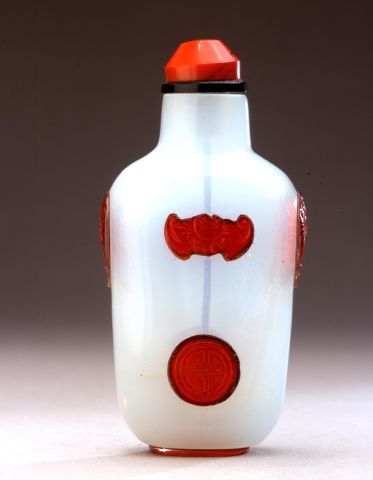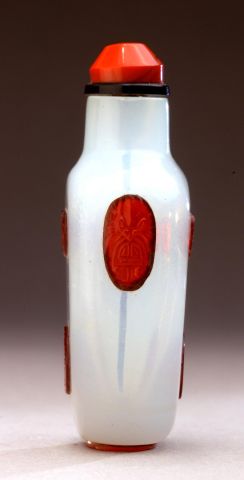

Bottle ID: 00058
WHITE W/RED & BROWN OVERLAY, BAT & SHOU MEDALLION
Date: 1750-1850
Height: 63 mm
Glass, of rectangular form with sloping shoulders, the opaque milk-white body overlaid in red with brown edging, with on front and reverse, a bat above a shou medallion, the sides overlaid with mock handles carved as a bat encircling a shou medallion, the base of the bottle carved in red with brown edging.
Attributed to Beijing.
Similar Examples:
Moss, Hugh, Victor Graham, and Ka Bo Tsang. A Treasury of Chinese Snuff Bottles - The Mary and George Bloch Collection, 2002, Vol. 5, Part 3, p. 643, no. 986.
Provenance:
Clare Lawrence Ltd.
Richard A. Bourne Co., Inc., Massachusetts, December 14, 1988, lot 147
Mrs. J. Gerald Mayer
Sotheby & Co., London, October 28th, 1969, lot 4
Exhibited:
Annual Convention ICSBS Toronto, October 2007
It is with some hesitation that this bottle is attributed to Beijing. In the nineteenth century, there were a number of commercial workshops continuing the glass carving tradition within Beijing but outside the Palace Workshops. The confusion with this bottle lies in its method of manufacture. It is a mold-blown glass bottle with applied decorative glass panels. This is not the normal method of manufacture of Beijing glass overlay bottles, where a base color is overlaid almost completely with a second color and the decoration, or overlay, then carved back to the ground color. A second typical method of manufacture would be for one or more colors to be placed in a molten state on the ground color and then carved - this was the usual manner in which a 'multi-colored overlay' would have been fashioned. This bottle does not appear particularly experimental or crude - it is elegantly made with great care taken in all aspects of its manufacture, from the design to the form of the piece. The opalescent glass is carefully made and blown while the details of the red and brown 'overlay' colors are well-carved and evenly applied to the main body. In concept, it is more akin to unglazed porcelain of the mid-nineteenth century where the relief decoration is applied to the body of the piece and the details then finely worked.
< Back to full list
 English
English 中文
中文